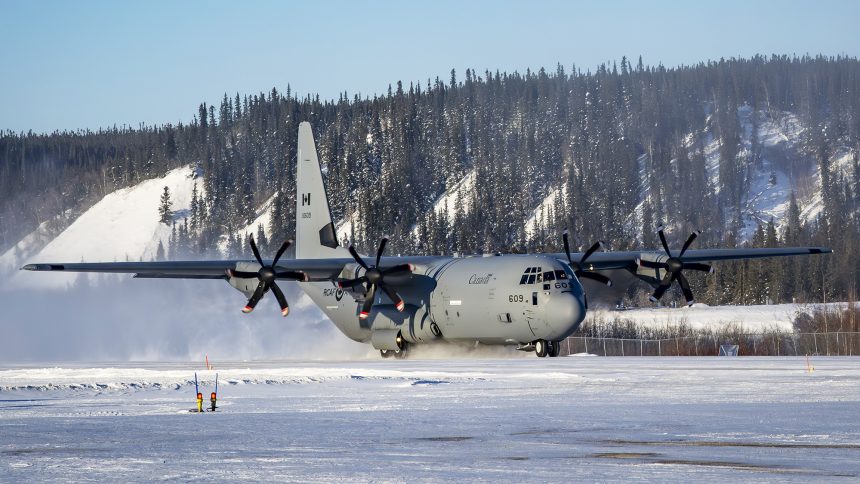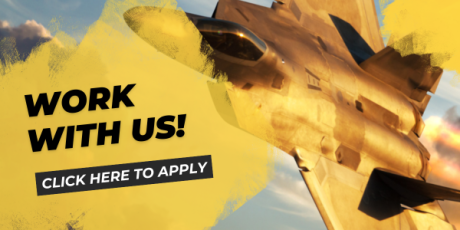Andrew Erskine, writing for Breaking Defense, advocates rapid procurement of strategic enablers to ensure Canada’s armed forces are properly equipped for growing requirements.
A research fellow at the Institute of Peace & Diplomacy, an international affairs think tank based in Canada, Andrew Erskine has used his expertise in Canadian and NATO defense policy to put forward a convincing case for Canadian military expansion. Rather than focusing on the sharp end of the stick – combat aircraft, like the F/A-18C Hornet which Canada currently intends to replace with the F-35A Lightning II – Erskine shifts attention to strategic and tactical airlift and sealift capabilities.
As the quote attributed to Second World War U.S. General Omar Bradley goes: “Amateurs talk strategy, professionals talk logistics”. Even in a world where fast, reliable international shipping is a fact of daily life, the long-distance distribution and support of military operations remains an extraordinarily complex task.
While Canada boasts no overseas territories, no carrier strike groups, and no large overseas bases of its own, it is by total area (land and sea) the second largest country in the world. Add to this a desire to take a shaping role in global affairs, most notably in support of Ukraine, and the benefits of being able to rapidly move forces and equipment of varying sizes across vast distances becomes clear.
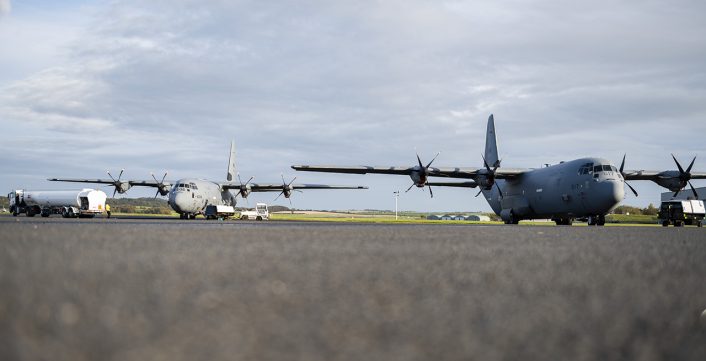
Erskine notes that the Royal Canadian Air Force, compared to many other air forces, does already operate a significant strategic airlift force. This includes five C-17A Globemaster III (designation CC-177) aircraft alongside a mixed fleet of C-130H and C-130J Hercules (designation CC-130). However, it is argued that there is a gap on the smaller end of Canada’s fleet, meaning valuable C-130 flight hours are used for domestic support and search and rescue operations which could otherwise be handled by an alternative aircraft.
Any alternative aircraft would need to match these types’ capability to operate from unprepared airstrips as well as have sufficient endurance performance to allow safe operations in the high Arctic and on long sorties over the ocean. Erskine suggests that Leonardo’s C-27J Spartan is the most sensible option here, arguing for the purchase of a fleet of between 8 and 10 aircraft. Even in North America, the Spartan would be no stranger to these types of tasks – 14 Spartans are operated in the medium range surveillance role by the U.S. Coast Guard, while seven more are operated by the U.S. Army Special Operations Aviation Command.
Pretty pics of one of the US #Coast Guard’s 14 Alenia/Leonardo C-27J #Spartan aircraft, all acquired from the #USAF and activated from storage. They go with about 16 HC-144A Ocean Sentrys bought directly for the Coast Guard fm EADS/Airbus. #USCG https://t.co/NGbjs4a56m pic.twitter.com/WJrDPLnB2U
— Chris Cavas (@CavasShips) February 22, 2018
These 10 Spartans, Erskine posits, would allow the Hercules force to be redeployed elsewhere. This boosts overall capability in two distinct areas with the acquisition of only one aircraft type. Canada uses its C-130s extensively for overseas missions, with at least one often accompanying any long-range fighter deployments.
The flying for the day may be done, but the Air Movement team at @RCAF_ARC Air Task Force Prestwick continues to work through the evening offloading pallets, preparing 🇨🇦 CC-130J Hercules for the next mission in support of 🇺🇦 and our other ops around Europe. pic.twitter.com/1laicn0qTB
— RCAF Operations (@RCAFOperations) February 2, 2023
Since 2022, Air Task Force Prestwick, at Glasgow Prestwick Airport in the UK, has formed a hub for the flow of Canadian military logistics through Europe. Using a forward deployed force of three C-130J Hercules, along with stopovers from other aircraft, Canada uses this base to support its military aid to Ukraine as well as its own operations in Europe, Africa, and the Middle East.
Sealift
Erskine next turns his attention to Canada’s sealift capability. As he notes, over the coming few years, Canada will commission two new Protecteur class joint support ships. These are multirole vessels capable not only of loading and transporting an array of cargo and military hardware across oceans but also providing other ships at sea with fuel and solid supplies.
They will eventually supplant MV Asterix, a converted container ship that has served Canada as a contracted naval auxiliary since 2017. While Asterix has a sizable capacity, its roots as a civilian vessel reduce its suitability for deploying in high-risk areas.
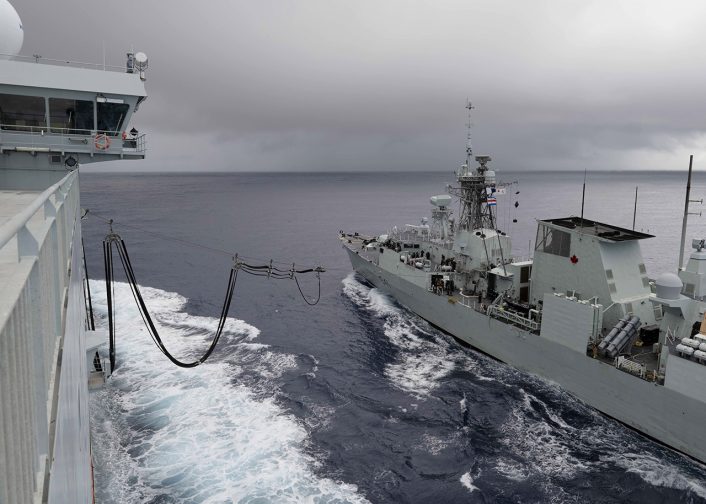
However, even with these two new vessels, Erskine believes there will still be a shortfall of sealift capacity for the Canadian armed forces. This is based not only on current requirements, but potential future requirements that could see a need for the transport of unmanned surface or sub-surface vessels to a forward location for onward deployment.
US #Navy has been testing the anti-mine #UISS Unmanned Influence Sweeping System using an all-aluminum #USV unmanned surface craft. Last wknd 14 Sept the system was operated in Chesapeake Bay fm the expeditionary sea base USNS HERSHEL WOODY WILLIAMS T-ESB4, a 1st for an MSC ship pic.twitter.com/9rRTEeszsq
— Chris Cavas (@CavasShips) September 17, 2019
Erskine argues that there is a requirement for two additional Protecteur class ships. Additionally, these would be of a modified design to incorporate a roll-on/roll-off (RO-RO) function. The U.S. Navy’s Military Sealift Command operates huge 60,000 ton ships with this capability, while the Royal Navy contracts four ships based on a commercial design.
RO-RO allows the rapid deployment of assets without reliance on vulnerable portside facilities. RO-RO ships can even unload directly onto temporary piers, pontoons, and raft vehicles such as Mexeflots. In times where infrastructure like cranes and container handling machines can be shut-down by an adversary through remote cyberwarfare targeting them or the electricity networks that supply them, the ability to operate entirely organically is a remarkably important consideration.
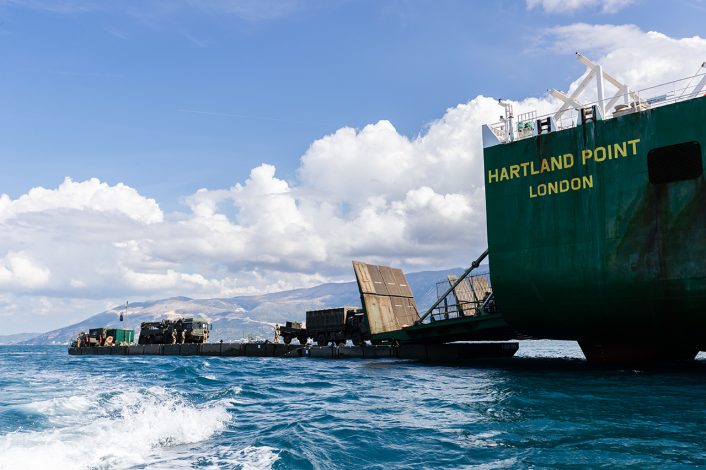
Reducing reliance on allied mobility is also a factor that must be considered while the strategic relationship between the United States and its NATO allies is in a state of flux. Cross-border relations between the U.S. and Canada themselves have been strained even further by the imposition of tariffs and the notion by President Donald Trump that the U.S. may renege on its long established border agreements with its northern neighbor. Communications referring to Canada as the 51st U.S. state have deeply angered many Canadians, causing the potential rethink of existing defense plans.
In light of these factors, Erskine states that the acquisition of these strategic enablers is a critical capability for Canada’s armed forces. Expansion is, he argues, not optional.

